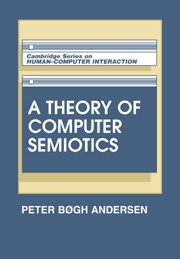 A Theory of Computer Semiotics
A Theory of Computer Semiotics II.1 - The basic means of expression
Published online by Cambridge University Press: 26 March 2010
Summary
Computer-based signs
I start my investigation of computer-based signs from the viewpoint of the expression plane, partly because the computer's means of expression are different from other media, partly because the history of linguistics tells us that expression analysis is easier than content analysis. What are the characteristic features of computer-based signs, and in which respects do they differ from other kinds of signs we know?
Handling, transient, and permanent features
The prototypical computer-based sign is composed of three classes of features:
A handling feature of a computer-based sign is produced by the user and includes key-press, mouse and joystick movements that cause electrical signals to be sent to the processor. Handling features articulate user actions.
A permanent feature of a computer-based sign is generated by the computer. It is a property of the sign that remains constant throughout the lifetime of a sign token, serving to identify the sign by contrasting it to other signs. Permanent features articulate system states into parts.
A transient feature of a computer-based sign is also generated by the computer, but unlike permanent features, it changes as the sign token is used. It does not contrast primarily to other signs, but only internally in the same sign, symbolizing the different states in which the sign referent can be. Transient features articulate system transformations.
As our first example, let us look at a version of the game Breakout. The system displays a paddle, a ball and a brick wall. The ball bounces back and forth, and the player must hit it with the paddle.
- Type
- Chapter
- Information
- A Theory of Computer SemioticsSemiotic Approaches to Construction and Assessment of Computer Systems, pp. 193 - 266Publisher: Cambridge University PressPrint publication year: 1991


